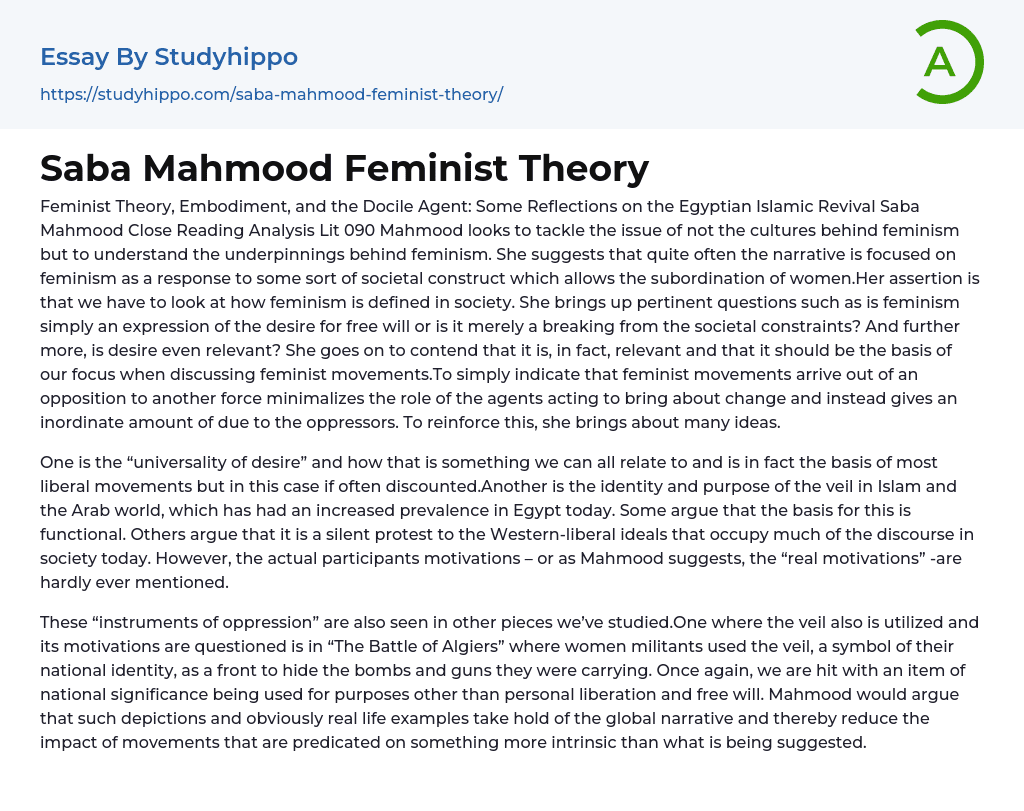Feminist Theory, Embodiment, and the Docile Agent: Some Reflections on the Egyptian Islamic Revival Saba Mahmood Close Reading Analysis Lit 090 Mahmood looks to tackle the issue of not the cultures behind feminism but to understand the underpinnings behind feminism. She suggests that quite often the narrative is focused on feminism as a response to some sort of societal construct which allows the subordination of women.Her assertion is that we have to look at how feminism is defined in society. She brings up pertinent questions such as is feminism simply an expression of the desire for free will or is it merely a breaking from the societal constraints? And further more, is desire even relevant? She goes on to contend that it is, in fact, relevant and that it should be the basis of our focus when discussin
...g feminist movements.To simply indicate that feminist movements arrive out of an opposition to another force minimalizes the role of the agents acting to bring about change and instead gives an inordinate amount of due to the oppressors. To reinforce this, she brings about many ideas.
One is the “universality of desire” and how that is something we can all relate to and is in fact the basis of most liberal movements but in this case if often discounted.Another is the identity and purpose of the veil in Islam and the Arab world, which has had an increased prevalence in Egypt today. Some argue that the basis for this is functional. Others argue that it is a silent protest to the Western-liberal ideals that occupy much of the discourse in society today. However, the actual participants motivations �
or as Mahmood suggests, the “real motivations” -are hardly ever mentioned.
These “instruments of oppression” are also seen in other pieces we’ve studied.One where the veil also is utilized and its motivations are questioned is in “The Battle of Algiers” where women militants used the veil, a symbol of their national identity, as a front to hide the bombs and guns they were carrying. Once again, we are hit with an item of national significance being used for purposes other than personal liberation and free will. Mahmood would argue that such depictions and obviously real life examples take hold of the global narrative and thereby reduce the impact of movements that are predicated on something more intrinsic than what is being suggested.
- Women's Suffrage essays
- Women'S Rights essays
- Women Empowerment essays
- Sojourner Truth essays
- Abortion essays
- Abuse essays
- Animal Rights essays
- Animal Testing essays
- Assault essays
- Bullying essays
- Controversial Issue essays
- Crash essays
- Cyber Bullying essays
- Feminism essays
- Human Rights essays
- Immigration essays
- Inequality essays
- Poverty essays
- Prejudice essays
- Racism essays
- Torture essays
- Violence essays
- Equality essays
- Gender equality essays
- Gender Inequality essays
- Minority essays
- Segregation essays
- Social Inequality essays
- Bias essays
- Big Five Personality Traits essays
- Body Image essays
- Mind essays
- Motivation essays
- Phobias essays
- Thought essays
- Experiment essays
- Explorer essays
- Hypothesis essays
- Observation essays
- Qualitative Research essays
- Research Methods essays
- Theory essays




